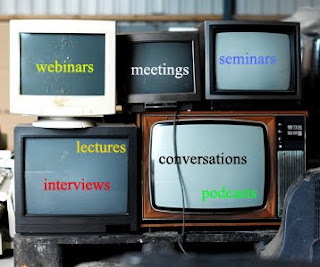Touch type as defined by wordnet.com is to type without looking at the keyboard. Most transcriptionist employ this method of transcribing ... except me.
Being in the transcription world for less than 10 years, I'm not that keen on this method. No offense meant on people using this technique but I just type as I please; in my head, type as you please, master your own method period. I have seen people applying the touch typing thing but it's not always the speed that counts. Many times, they hit the backspace button more often than I do, even worse, create more mistakes than me.
In my opinion, follow what suits you best or what makes your boat float. Just like photography, learn the basics and then formulate, experiment and create your own style.
There's no rule on what to follow in the way you transcribe, what matters is to be sure that you are writing down the accurate words dictated, no more and no less. Just like everybody else, find what's comfortable with you.
Happy transcribing!
World of Transcription
Transcription in all sizes and shapes.
Sunday, August 8, 2010
Sunday, July 11, 2010
General Transcription 101

General transcription is a type of transcription which ranges from podcasts, meetings, webinars, interviews, meetings,lectures and so on and so forth. It deals with a lot of things also, from a simple conversation of a client, a lecture explaining a new product, new medical breakthroughs, etc.
Because of its vast topics, patience plays a big part of doing this kind of transcription in terms of researching. There are times that the clients give a "hint" on what the recording is all about, but often times, you get the gist of the topic as you transcribe the dictation. It's a must to stay focused on the topic on hand.
It's important to know the clients specifications because sometimes, clients base their payments on the specific instructions they give for that particular report. Be it the spaces, speaker headings, punctuation marks, time stamps, etc., a transcriptionist should always adhere to these specifications to ensure a good working relationship with the client.
When it's a conversation, lecture or interview type of transcription, one must master the changing of speakers, distinguishing who's speaking is the tricky part of the report. Sometimes, one gets lost on this part of the report because speakers often overlap in the conversation, so be on the lookout of changing voices.
Always stick to the turnaround time agreed upon. Some clients are very strict on this especially if the job they gave you has a deadline on their part too. Some will also give you an extension if they deem that the report wouldn't make it on time, especially if the type of report is a bit challenging for the transcriptionist's part. It is important to keep the communication lines open between the client and transcriptionist regarding this part so that it ensures a good working relationship on both ends.
Payment on this type of transcription is based on an audio hour rate. Sometimes it ranges from $10 up to $30 per audio hour recording and could sometimes depend on the quality of audio encountered.
General transcription is an ideal avenue for transcriptionists who love to do various types of topics, which unlike medical transcription and legal transcription are specifically categorized. General transcription covers almost all sorts of topics from A-Z, name it, they have it. There are 4 things to remember in general transcription, listen, transcribe, research and focus.
Sunday, July 4, 2010
Five underscores and then some ...

To (leave it) blank or not to blank, that is the question. Well, it's a no-brainer, if all else fails, leave it blank, let the editor handle it ... NOT! As someone who has been in this business for quite sometime, the transcriptionist should be responsible with the report they're doing. I mean it doesn't hurt if you do some research on the topic, report, disease, etc. Well, I understand if the dictation is really unacceptable (poor audio, ESL dictators, etc.) but transcriptionists should always be ready with these kinds of files. We're lucky if we can return the audio file because of such reasons, but you know how it is, work is work, no work, no pay equals sad face. But the thing is, one should give their best with whatever comes their way, effort is a virtue. In my experience, I have encountered instances such as dictators who talk like their whispering to the device (maybe a top secret patient, hehe), odd environments(restaurants, parks, car, etc.) and dictators who have poor command of the English language.
Given that we cannot predict the type of work we get, except in medical transcription wherein we get to be acquainted to the doctor's style of dictating things, we should always give our 100% effort.
Never get tired of doing research. It's a fulfillment not to have a blank in a report knowing that you did your best to avoid doing so. It is also helpful to have someone who could also listen to your blank, but please don't let the person listen to the whole dictation, let alone fill in all your blanks.
Another thing is to review your work. Maybe blank #1 is the same with blank #4, always take time to review your entries. With this in mind, less blanks results to well-written reports.
Bottom line is, do your best, research, ask for help and review your work. The transcription world is filled with all sorts of reports, never expect reports to be the same day in and day out, be always prepared.
Saturday, July 3, 2010
Transcription Gear

In the transcription world, aside from your eveready desktop computer or your laptop, the other things needed for transcription are the following gear. Let's start from the top ...
- Headset - A very durable ear buddy is one of the essentials in transcription. Earphones, headphones or whatever suits you best must be comfortable in the ears and gives optimal sound quality. There are a lot of types of headsets available in the market today. For the medical transcriptionist, the U-shaped headset is the most common type used. In my experience, this is the most optimal headset because of its design, being lightweight, flexible and its long cord. Earphones used for your MP3s, iPods and the like are also okay to use with transcription. The type of headset you choose to use plays an integral part in transcription, so better choose right.
- Keyboard - The typical keyboard is okay to use, but an ergonomic one is better. Carpal tunnel syndrome (CTS) is one of the most prevalent disorder in a transcriptionist due to the repetitive movements made in typing. CTS can be avoided with proper placement of the keyboard, proper typing and some exercises can prevent CTS from occurring.
- Foot pedal - Foot pedals come in different designs and connection. There are the 2-step and 3-step pedals, and those with USB and cable connections. Nowadays, transcriptionists have the freedom to choose whether to buy those manufactured abroad or those made by local "MT-prenuers" who design and develop foot pedals which are not that pricey than the branded ones in the market.
These 3 are the essentials for transcription. Though some do transcription sans the use of a foot pedal, but in my experience it's better to have these big 3 paraphernalia available because these produce better results in transcription.
The Medical Transcriptionist

By the simplest term, medical transcription is a profession wherein a medical transcriptionist (MT) translates physician recorded reports into written reports for better documentation of the patient's health history.
According to the American Heritage Medical Dictionary, a medical transcriptionist is a person who transcribes medical reports dictated by a physician concerning a patient's health care. The MTs return these documents to the physicians for their review, make the necessary corrections and affix their signature if these are done accurately. After these are done, the documents are now part of the patient's record or profile.
Aside from the transcriptionist, editors and quality assurance (QA) editors are also employed for a more thorough review of the report.
Often times, those who graduated with a background in the medical field such as physical therapists, nurses, medical technologists, etc. have an edge in this profession, but those who have enrolled in Medical Transcription courses are also qualified and considered for this field.
Aside from having a deep knowledge in medical terminologies, it is a must to possess good English grammar, punctuation skills, excellent hearing acuity, an eye for details and being computer and Internet savvy makes a good medical transcriptionist.
In my book, it's a job that both is rewarding both intellectually and financially as long as you work hard, you love your work and be passionate about it. I am proud to be a medical transcriptionist and as they always say, many are called, but few are chosen.
Subscribe to:
Posts (Atom)